Flechtner F.M., Gruber Th., G?ntner A., Mandea M., Rothacher M., Sch?ne T., Wickert J. (Eds.) System Earth via Geodetic-Geophysical Space Techniques
Подождите немного. Документ загружается.

Global Atmospheric Data from CHAMP and GRACE-A 441
Wickert J, Gendt G, Beyerle G, Dick G, Heise S, Helm A, Reigber Ch, Schmidt T, Jakowski N,
Jacobi Ch (2007) Ground and space based GPS atmospheric sounding: Brief overview and
examples. Intl Meeting Tropical Radar Network, NARL Publication, Tirupati, India, pp. 1–10.
Wickert J, Jakowski N (2007), GNSS based sounding of the Atmosphere/Ionosphere in: National
Report of the Federal Republic of Germany on the Geodetic activities in the years 2003–2007,
ISBN 3 7696 8595 4, pp. 125–129.
Wickert J, Schmidt T, Beyerle G, Heise S, Reigber Ch (2006) Global atmospheric sounding with
GPS radio occultation aboard CHAMP. In: Flury J, Rummel R, Reigber Ch, Rothacher M,
Boedecker G, Schreiber U (eds.), Observation of the Earth System from Space, Springer,
Berlin, pp. 55–77.
Wickert J, Beyerle G, König R, Heise S, Grunwaldt L, Michalak G, Reigber, C, Schmidt T (2005)
GPS radio occultation with CHAMP and GRACE: A first look at a new and promising satellite
configuration for global atmospheric sounding. Ann. Geophysicae 23, 653–658.
Wickert J, Schmidt T, Beyerle G, König R, Reigber C, Jakowski N (2004) The radio occulta-
tion experiment aboard CHAMP: Operational data processing and validation of atmospheric
parameters. J. Meteorol. Soc. Jpn. 82, 381–395.

Near-Real Time Satellite Orbit Determination
for GPS Radio Occultation with CHAMP
and GRACE
Grzegorz Michalak and Rolf König
1 Introduction
One of the CHAMP and GRACE mission objectives is to perform radio occultation
measurements of GPS signals propagating through Earth’s atmosphere. From these
measurements it is possible to derive vertical profiles of bending angles, temperature
and humidity of the atmosphere on a global scale which can be used by numerical
weather prediction systems (NWP). To fulfill this mission objective, rapidly avail-
able precise orbits and clock offsets both for occulting GPS satellites and the Low
Earth Orbiters (LEOs) are required. Efficient occultation data assimilation in the
NWP systems requires a 3 h time line for occultation products. As the orbits are
needed to generate the occultation products, the latency of the orbit products is
required not to exceed 0.5 h. For this purpose a Near-Real Time (NRT) orbit pro-
cessing system was developed to generate precise GPS, CHAMP, GRACE-A and
TerraSAR-X orbits with a mean latency of 15–30 min (Michalak et al., 2007). The
orbit latency is defined here as a difference between the epoch of the orbit gener-
ation and the epoch of the last data point used in the processing. The space-borne
GPS Satellite-to-Satellite Tracking data (SST) and the occultation data can be down-
loaded (dumped) from each LEO once per revolution, approximately every 1.5 h.
Processing of the most recent dump, containing 1.5 h of occultation data, starts
when the NRT orbits become available. The typical processing time of the occul-
tation data is 0.5 h; taking into account additional 0.5 h of NRT orbit latency, the
delay of occultation products generated from the recent dump is between 1 and 2.5 h
(on average 1 h 45 min). This delay meets the 3 h timeline and the data can be suc-
cessfully assimilated by the weather centers (Wickert et al., 2009). Dumping of the
SST data in each revolution is assured for near polar satellite orbits by operating a
GFZ’s northern latitude receiving station in Ny
´
Ålesund. To enhance reliability and
to test different approaches of orbit generation, three independent NRT processing
G. Michalak (B)
Helmholtz Centre Potsdam, GFZ German Research Centre for Geosciences,
Department 1: Geodesy and Remote Sensing, Telegrafenberg, 14473 Potsdam, Germany
e-mail: michalak@gfz-potsdam.de
443
F. Flechtner et al. (eds.), System Earth via Geodetic-Geophysical Space Techniques,
Advanced Technologies in Earth Sciences, DOI 10.1007/978-3-642-10228-8_39,
C
Springer-Verlag Berlin Heidelberg 2010
444 G. Michalak and R. König
chains were developed delivering the orbits with different accuracies and latencies
which can be used also for other applications according to their accuracy/latency
requirements. Details of the different approaches are given in the following sections.
2 NRT Orbit Processing System
The Near-Real Time LEO orbit processing system is based on so-called two step
approach in which the LEO orbits are estimated using fixed GPS orbits and clocks
estimated before. For this reason the system consists of two separate subsystems.
One is designed to generate GPS NRT orbits and clocks; the second one generates
LEO NRT orbits. The estimation of the GPS orbits and clocks is performed by using
data of 30–60 stations of a globally distributed GPS ground network from IGS. The
modelling standards and estimated parameters are very similar to those used for
the so-called Rapid Science Orbits (Michalak et al., 2003). Since the processing
of the GPS ground data is the most time consuming part, for the NRT application
this processing was split into a long and a short arc. The long 24 and 12 h GPS
arcs (see details below) are generated on an hourly basis and parallel to this the
short 3 h arcs extending the long arcs are generated every 15 min. The generation
of the short arcs is fast and gives access to GPS orbits and clocks with low latencies
of approximately 15 min, where waiting and downloading of the GPS data takes
10 min, and processing takes less than 5 min. Subsequent 14 h LEO NRT arcs are
based on the combination of the most recent long and short GPS arcs. The LEO
NRT processing starts as soon as new space-borne GPS satellite-to-satellite (SST)
data become available, downloaded from the satellite or “dumped”. Therefore this
way of processing is called dump-related. Typical delay in access to SST dump data
for CHAMP and GRACE is in the range of 5–10 min. To assure high reliability and
to test possible accuracies and latencies, the NRT orbit processing system was split
into three separate chains which generate LEO orbits based on different sets of GPS
orbits. The description of the chains (CHAIN 1, CHAIN 2 and CHAIN 3) is given
below. In addition to CHAMP and GRACE, the TerraSAR-X satellite, launched on
June 15, 2007 was also included in the NRT system. The accuracy of the LEO NRT
orbits is determined by independent Satellite Laser Ranging (SLR) observations.
Accuracies and latencies achieved for all LEOs and for all chains are summarized
in Table 1. The previously running Ultra-rapid Science Orbit (USO) system (König
et al., 2005) delivering LEO orbits with latencies above 2 h was eventually shut off
and replaced by the new NRT system in September 2007. The latencies for USO
and NRT processing for CHAMP are given in Fig. 1.
2.1 CHAIN 1: GPS-Based Processing
In this chain, called “GPS-based”, the 14 h LEO orbits are based on the combination
of 24 and 3 h GPS orbits and clocks, estimated from the GPS ground station data
with 5 min spacing. The 3 h arcs are predictions originating from the long 24 h arcs,
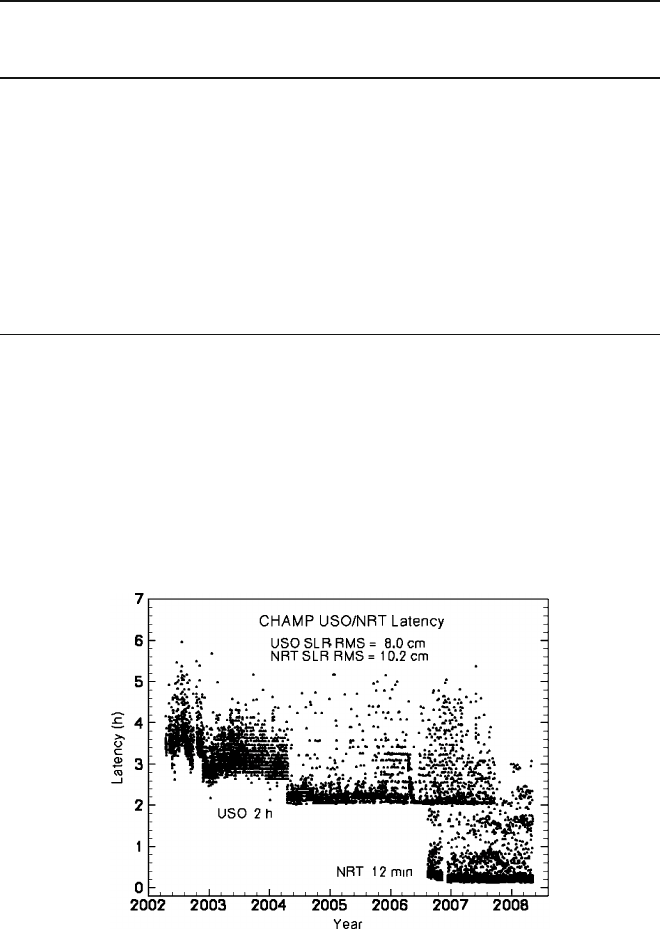
Near-Real Time Satellite Orbit Determination for GPS Radio Occultation 445
Table 1 Summary of the accuracies and latencies of the 14 h NRT LEO orbits for various NRT
processing chains. For calculation of the position and velocity overlap values, the last 2 h of the
LEO arcs are used. Latency is defined as the difference between the orbit generation time and the
epoch of the last available SST observation used in the processing
SLR RMS (cm)
3-D Pos.
overlap (cm)
3-D Vel.
overlap
(mm/s) Latency (min)
CHAMP Period 2006/08/17–2008/12/15
CHAIN 1 (GPS-based) 6.8 11.5 0.11 31
CHAIN 2 (IGU-based) 9.6 18.8 0.18 13
CHAIN 3 (IGU-fixed-30s) 5.1 6.5 0.07 30
GRACE-A Period 2006/08/22–2008/12/15
CHAIN 1 (GPS-based) 7.6 11.0 0.09 31
CHAIN 2 (IGU-based) 10.6 19.2 0.17 13
CHAIN 3 (IGU-fixed-30s) 6.0 7.0 0.06 30
TerraSAR-X Period 2007/08/27–2008/12/15
CHAIN 1 (GPS-based) −−––
CHAIN 2 (IGU-based) 9.8 17.8 0.17 30–60
CHAIN 3 (IGU-fixed-30s) 5.6 5.4 0.06 30–60
but the 5 min clocks are estimated. The latency of the3hGPSorbitsiscurrently
approximately 20 min, where 15 min is the waiting and data downloading time, the
remaining 5 min is the data processing proper. Currently the 3-D accuracy of the
short 3 h GPS arcs, when compared to the estimated part of the Ultra Rapid Orbits
(IGU) of the International GNSS Service (IGS) is 19 cm (see Fig. 2). The LEO
orbits are generated with an average latency of 30 min and an accuracy of 7 cm
Fig. 1 The l atency of the CHAMP orbit generation for two systems: USO and NRT. The NRT
latency comes from the CHAIN 2
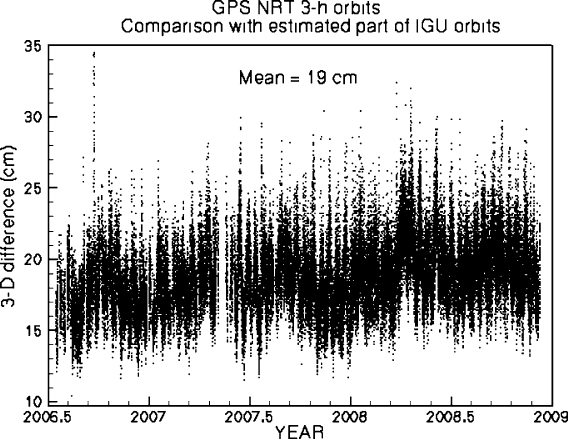
446 G. Michalak and R. König
Fig. 2 Position differences between the GPS NRT orbits (3-h arc length) and the estimated part of
the IGU orbits
validated by independent Satellite Laser Ranging (SLR) measurements. This chain
is not active for the TerraSAR-X satellite.
2.2 CHAIN 2: IGU-Based Processing
In this chain, designated as “IGU-based”, the 14 h LEO orbits are based on purely
predicted IGU orbits and clocks. Since the s pacing of the IGU orbits and clocks is
15 min, for processing of the 30s SST data the IGU clocks are linearly interpolated
to 30s intervals. Because there is no ground GPS data processing involved, the LEO
orbits can be generated very rapidly with a mean latency of 13 min, but a comparably
low accuracy of 10 cm (via SLR validation). This low accuracy is mainly caused by
the predicted IGU clocks used as fixed in the LEO processing. The chain i s very
robust because it depends solely on the availability of the IGU orbits and the SST
dump data; no GPS ground data are needed. Accuracies and latencies of the NRT
orbits for CHAMP, GRACE-A and TerraSAR-X satellite generated by this chain are
given in the Figs. 3, 4, and 5.
2.3 CHAIN 3: IGU-Fixed-30s Processing
This chain, designated as “IGU-fixed-30s”, generates LEO orbits based on fixed pre-
dicted IGU orbits, but 30s clocks estimated from GPS ground data. Since estimation
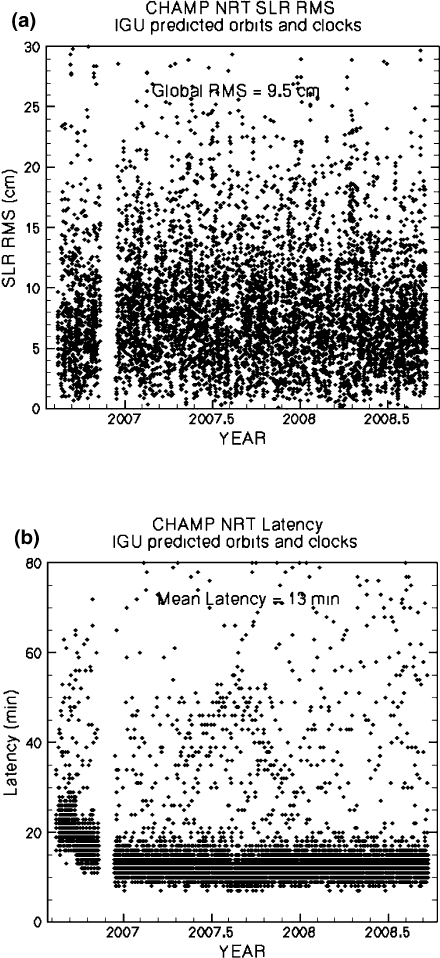
Near-Real Time Satellite Orbit Determination for GPS Radio Occultation 447
Fig. 3 (a) Accuracy of CHAMP NRT orbits generated by CHAIN 2. (b) Latency of CHAMP NRT
orbits generated by CHAIN 2

448 G. Michalak and R. König
Fig. 4 (a) Accuracy of GRACE-A NRT orbits generated by CHAIN 2. (b) Latency of GRACE-A
NRT orbits generated by CHAIN 2
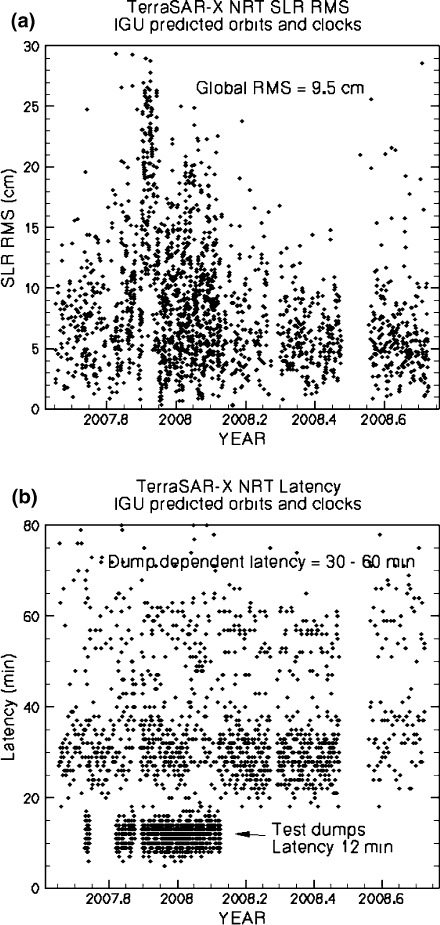
Near-Real Time Satellite Orbit Determination for GPS Radio Occultation 449
Fig. 5 (a) Accuracy of TerraSAR-X NRT orbits generated by CHAIN 2. (b) Latency of TerraSAR-
X NRT orbits generated by CHAIN 2. Due to lacking of the data from polar receiving station Ny
´
Ålesund, the data are significantly delayed. Test dumps over Ny
´
Ålesund demonstrated very low
latency also for TerraSAR-X
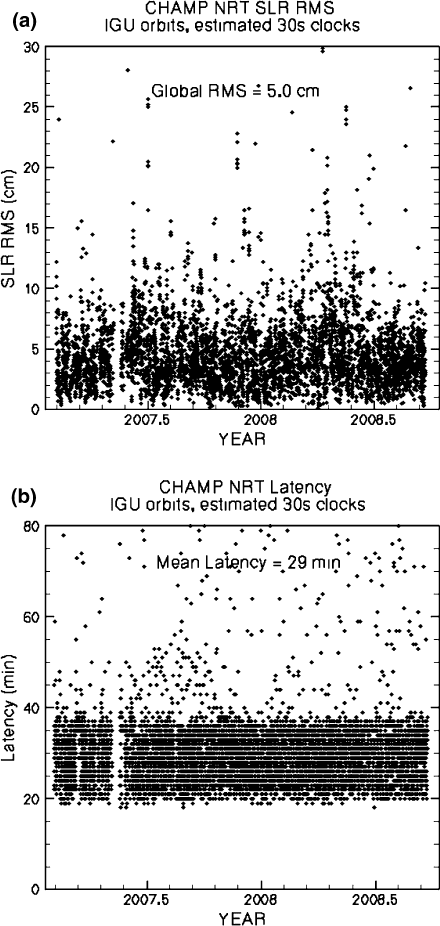
450 G. Michalak and R. König
Fig. 6 (a) CHAMP NRT orbit accuracy generated by the CHAIN 3. (b) CHAMP NRT orbit
latency generated by the CHAIN 3
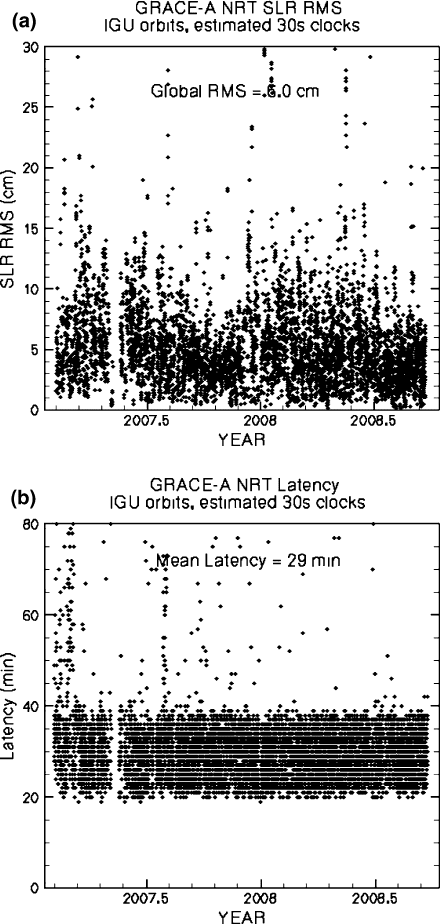
Near-Real Time Satellite Orbit Determination for GPS Radio Occultation 451
Fig. 7 (a) Accuracy of the GRACE-A NRT orbits generated by CHAIN 3. (b) Latency of the
GRACE-A NRT orbits generated by CHAIN 3
